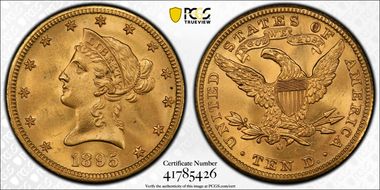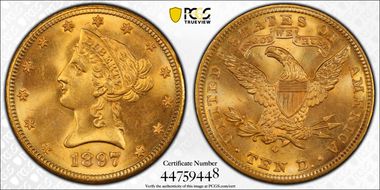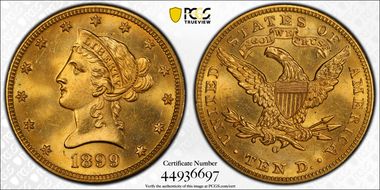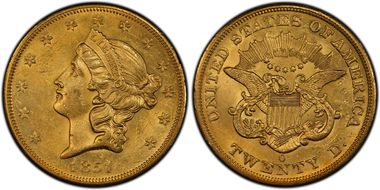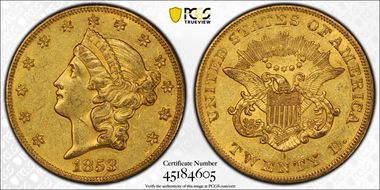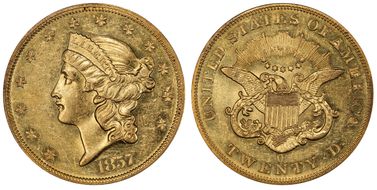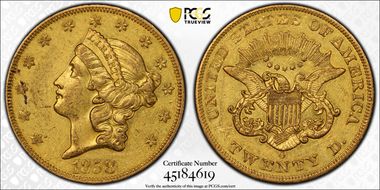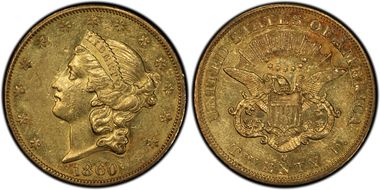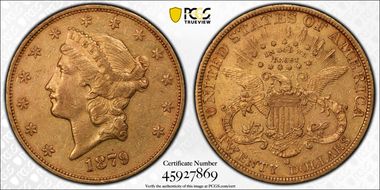400 Esplanade 的钱币相册
Winter V-1: weak stars at the top, bolder at the bottom. GOLD CAC. Ex: Duckor, Simpson.
Winter V-1. The date punch entered the date slightly higher than the other variety. Among all gold dollars struck in New Orleans, the 1853-O is the easiest to locate in all grades. With a mintage of 290,000 coins, it is tied with the 1851-O for the highest mintage gold dollar of this Mint.
Winter V-2. Ex: Harry Bass, Jr via John Rowe and Mike Brownlee privately 2/24/1967 and impounded in the ANA Money Museum in Colorado Springs until its current release. CAC
Winter V-2: Low date, close fraction. This is the finest known of the close fraction group. The 64, 4+, and 5 are all wide fraction. This is a late die state with shattering.
Winter V-1. The mint mark is large and high compared to the other 2 varieties and diagonal lines are seen above ST in STATES. The strike is notably weak at the center, also a characteristic of this variety. From a mintage of 33,580, about 100-125 remain. This coin is probably a 62-63 technically with no visible wear, but the strike is very soft. CAC
Winter V-1. The fields are remarkably prooflike and this is a fully struck example-a rarity for this already rare issue.
Winter V-4. The obverse has a low date with associated die cracks (Obv2). The reverse has cracks thru STATES (RevD). The New Orleans Mint struck a total of 364,002 Quarter Eagles in 1843. This mintage figure can be divided into two uneven portions based on the two different date types that Mint employees used. The majority of the 288,002 pieces were coined with a Small Date logotype also identified as having a crosslet 4. The rest are a Large Date type and the 4 has no crosslet.
Winter V-3. The mint mark extends rightward past the fraction bar, and the feather enters the center of the 'O'. This is an issue that is notable for weak strikes.
Winter V-1. Ex: Bass. The one is buried in the dentils and is doubled at its base (Obv1). The Mint Mark is penetrated by arrow feathers and is centered over the fraction bar (RevA). The provenance is not on the holder but matches the Bass II 407 coin, formerly PCGS MS63 at the time of sale in October 1999. There is a copper spot on the reverse at the 2. Thank you Stephen Davidson for locating this coin.
Winter V-4. Low date with recut 5. MM left touching claw. There are a number of underrated issues among New Orleans gold coins. The current issue would certainly be one of them. Long considered to be virtually unknown in Mint State grades, recently a few pieces have been certified in grades as high as MS64, yet coins as fine as the present example remain few and far between. This piece, unusual for the date, has a nearly full strike. Ex. Grand Lake Collection (HA 2/09).
Winter V-2. No evidence of repunching or doubling of date. This is the rarer variety.
Winter V-1. Ex: Harry Bass. This is the rarer of the two varieties according to Doug Winter and is notable for the tail feathers penetrating the mint mark.
Winter variety unmatched. The 1 is in the neck (Obv5) and the MM is left enough that no feathers puncture it (RevA)
Winter V-1. Ex: SS Central America. CAC
Winter V-2. The more common variety struck from lapped dies. The 1854-o is the first year of issue and the only $3 coin produced at the New Orleans branch mint. With a total mintage of 24,000, most of the coins were presumed to be released into circulation or melted. Only 2 mint state examples are currently slabbed by PCGS (an MS61 and an MS62). Though around 1000 are preserved in PCGS and NGC slabs, the popularity among us collectors make this a difficult date to locate in any grade.
Winter V-3. Narrow Mill. Unique 'railroad rim' error. Ex: Eliasberg, Bass.
Winter V-2, This is die state II according to Doug Winter's new book. There is a light die crack from star 12 to rim and light peripheral cracking on the reverse. From the New England collection.
Winter V-3. MM is lower and tilted left, right shield line curves inward. Despite a mintage of 58,000, the 46-o is rarer than the 45-o (41,000). According to Doug Winter's book on New Orleans gold, only 4 or 5 uncs are known and the population figures at PCGS and NGC likely represent resubmission of the same few uncs. This coin has a lovely cameo effect with prooflike fields. Marks through the eagle's head and neck are on the holder. CAC.
Winter V-1. The only known variety. The 47-o is the rarest of the o-mint half eagles. According to Winter's reference, there may be only 40-50 known in all grades and in properly graded AU55 there are no more than a few pieces known. There is one MS61 at NGC and likely only one other coin that would grade AU58.
Winter V-2. Ex: Reportedly resided in a Wayte Raymond coin board prior to auction via The Old Colony Collection (ANR, 12/2005), Allan H. Goldman Collection.
Winter V-1. MM is lower and more left compared with v2. Doubled 'R' in AMERICA.
Winter V-1. Ex: SS Central America. CAC.
Winter V-1: The only known variety. The reverse is the same as on 55-o. This is the least produced half eagle along with the 92-o at 10,000 minted.
Winter V-1. Ex: Fairmont. Reportedly, this is the best of the last of a group of hand selected coins from a European hoard of 400k+ US gold coins kept in vaults for 100+ years. CAC.
Winter V-1. The mintmark is positioned left of the crotch near the fletchling and claw.
Winter V-1. The mintmark is positioned left of the crotch near the fletchling and claw.
Winter V-2. The o is lower than V-1. V-1 uses the 41-o reverse. Only 27,400 eagles were produced in 1842.
Winter V-2. No die cracks on reverse, stronger date. Submitted raw from a long held collection in CO. Graded by several trusted numismatists higher than the current label. Absolutely fresh and probably warrants a '+' at the very least. Likely also the finest known to date (2021).
Winter V-1. This date is notable for one of the most important coins produced by the New Orleans Mint...a remarkable NGC PR66 that traded for 1.5 mil in 07!!! It is not known why this single proof was produced. OGH.
Winter V-1A. Repunched date with MM centered over the N of TEN. In hand, this coin is very flashy and this is not captured by the images provided. CAC
Winter V-1. Ex: Warren Miller. The rarity of MS64 'no motto' Eagles from the New Orleans mint cannot be overstated. Fewer than 10 are likely to exist at MS64 and above. OBH. CAC.
Winter V-1. Ex: SSCA. Cracked out of special large holder to upgrade, but not by me. CAC
Winter V-1. The only small date variety. It is unknown how many of the 52,500 delivered were of the small logotype. Doug Winter estimates that the small date is more common overall, but more difficult in higher grade. Only 1 low grade unc is known at PCGS and 2 at NGC.
Winter V-1: normal date. The average 1855-o is heavily abraded and has lack luster eye appeal. There are only 2 known uncirculated coins, both MS61s in PCGS holders. Less than 100 of the original 18,000 are thought to have survived.
Winter V-1. Ex: Clapp, Eliasberg, Harvey Jacobson (per DW, but not on holder). CAC
Winter V-1. This coin has no known provenance, but on close inspection a lot of dirt is seen in the protected areas ie.- around the stars, within the numerals. I suspect this coin might be from the Tennessee Hoard of 1985...but no proof exists. This coin is so super-original with a beautiful matte finish. It is very minimally abraded just as the pictures show and in my opinion is quite conservatively graded. OGH. CAC.
Winter V-1. Ex. SS Republic. In October 1865 after the Civil war ended, the ill-fated sidewheel steamship left New York en route to New Orleans with gold, silver, and commercial cargo to resupply the depleted Southern economy. The ship sank one week later 100 miles SE of Savannah, GA on October 25 in a hurricane. Passengers and crew escaped, but the ship and her booty were lost. In 2003, Odyssey Marine Exploration located the wreck and began the process of recovery. Some amazing rarities came out of the treasure, including the 2 finest known 59-o $10s. Sea salvaged silver coins from the wreck were etched by decades of exposure to salt water. However, the gold coins were largely unaffected. This coin is amazingly well preserved though abraded. I cannot find rub on this coin, but perhaps muted luster on the obverse prevents a higher designation. The protected areas are bright and prooflike, and the reverse is easily MS62. The 1859-o is the rarest "No motto" eagle with a total mintage of 2300 and survival is estimated at 45-55 coins.
Winter V-1. Ex: Admiral Collection. Definitely not a 55, and most likely a 60-61 by today's standards. There is no visible difference in this coin and the professionally photographed 80-o MS61, the next entry in this collection. OGH. CAC.
Ex: Clapp/Eliasberg. J.M. Clapp purchased this eagle directly from the mint at 400 Esplanade Avenue in New Orleans in 1903 and it was passed on to his son after his death in 1906. It was then sold to Louis Eliasberg after J.H. Clapp died in 1942. The coin was sold at auction in the Eliasberg sale of 1982. It had reportedly not changed hands since the Eliasberg sale...until now. OGH. CAC
Winter V-1. Hundreds have been located overseas in the last decade according to Doug Winter. There is one interesting coin for this issue, possibly a specimen or proof strike. A note accompanies that coin, "First Gold Coined 1904, W.J.Bromphy, Coiner US Mint, $10.00 and $5.00" Interestingly, no gold half eagles are currently known for this date?!?!
Winter V-1. The 1852-o is the most available New Orleans double eagle in higher grades with 12-18 Unc's available.
Winter V-1: the only known variety. From a mintage of 8,000, probably 70-80 remain. None of these are full unc's despite a few in NGC60 holders according to Winter. Overall, this issue is considered the 3rd rarest among New Orleans double eagles. CAC.
Winter V-1: Per Doug Winter, "I doubt if more than three or four have what could be termed as “positive” eye appeal. The typical 1859-O has been stripped and shows excessive abrasions. Pieces with original color and skin are rare, rare, rare!! It has been years since I’ve seen an 1859-O which I’ve liked. This coin? I LOVE it…Housed in an old green label holder and clearly undergraded by today’s standards; I think virtually anyone viewing this coin will call it a solid AU55." Hmm, 'nuff said! OGH. CAC.
Winter V-1. Tied for finest known (2015). Repatriated from France-very PL. CAC.
Winter V-1. Tied for finest known (2015). Repatriated from France-very PL. CAC.




















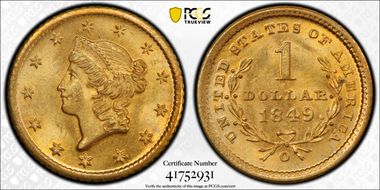
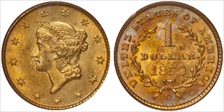
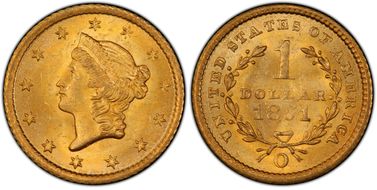
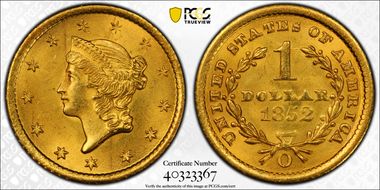
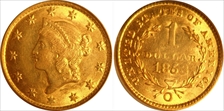
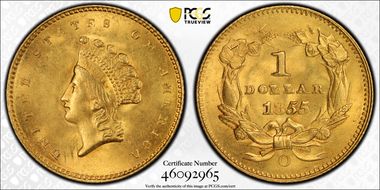
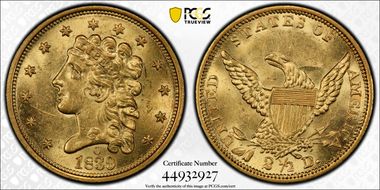








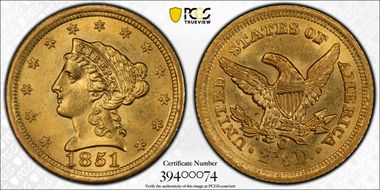






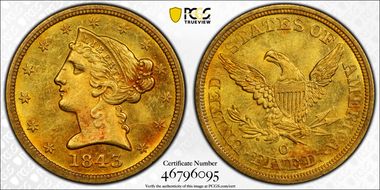


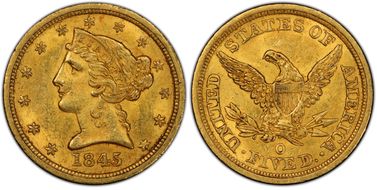






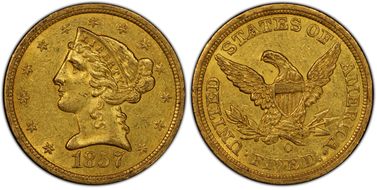
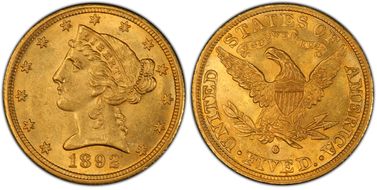
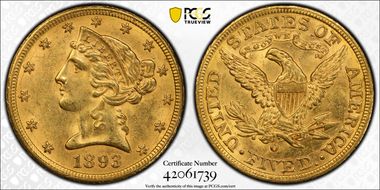









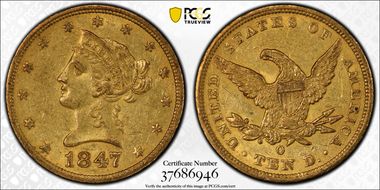



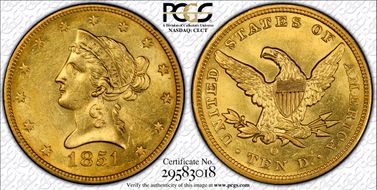
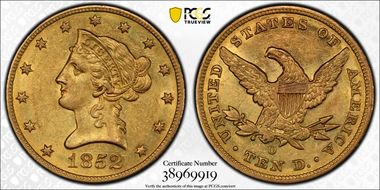



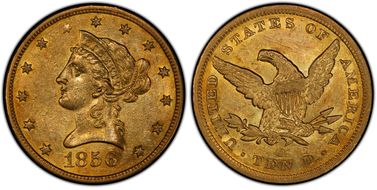
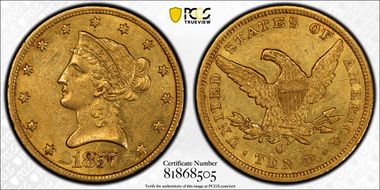





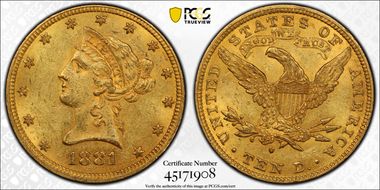
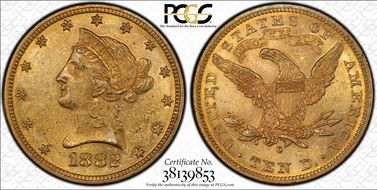
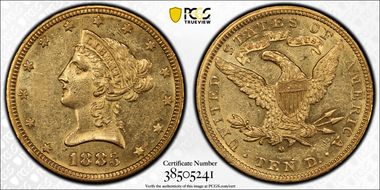

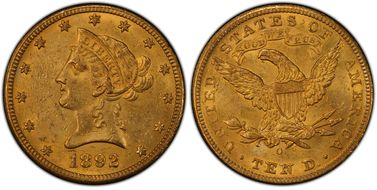
_album.jpg)

